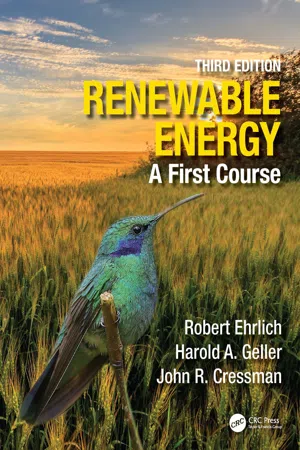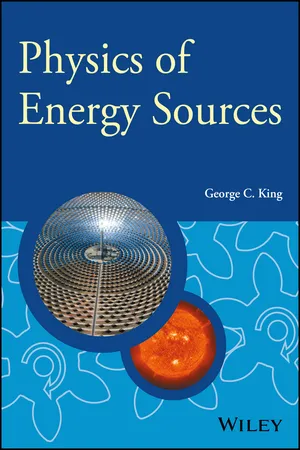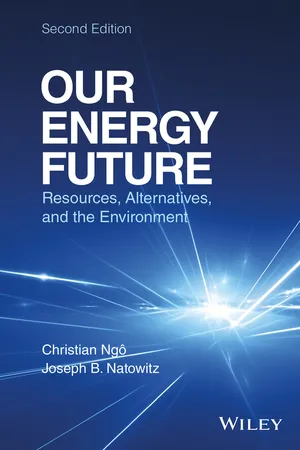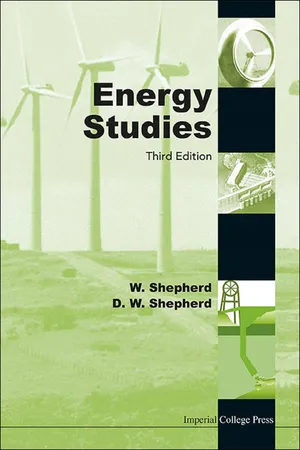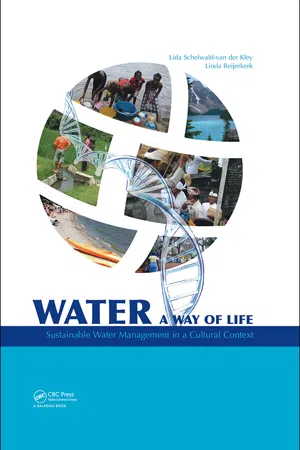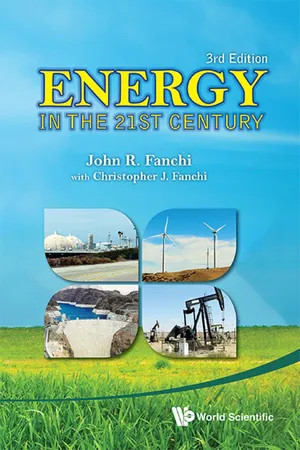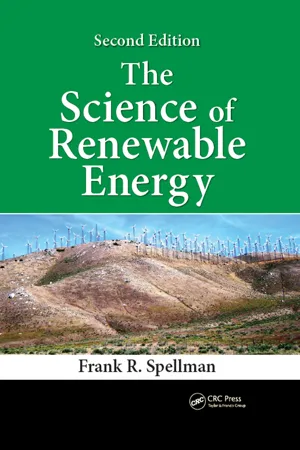Geography
Water Power
Water power refers to the energy harnessed from the movement of water, typically through the use of hydroelectric dams or turbines. It is a renewable and sustainable energy source that can be used to generate electricity. Water power plays a significant role in geography, influencing the distribution of settlements and industries near water bodies with potential for hydroelectric power generation.
Written by Perlego with AI-assistance
Related key terms
Related key terms
1 of 4
Related key terms
1 of 3
9 Key excerpts on "Water Power"
- eBook - ePub
Renewable Energy
A First Course
- Robert Ehrlich, Harold A. Geller, John R. Cressman(Authors)
- 2022(Publication Date)
- CRC Press(Publisher)
HydropowerDOI: 10.1201/9781003172673-8Contents
- 8.1 Introduction to Hydropower
- 8.2 Wave, Tidal, and Ocean Thermal Power Resources
- 8.3 Introduction to Tidal Power and the Cause of Tides
- 8.4 Ocean Thermal Energy Conversion
- 8.5 Social and Environmental Impacts of Hydropower
- 8.6 Summary
- Problems
- Reference
8.1 Introduction to Hydropower
Hydropower, in which the motion of water is harnessed to do useful work, is essentially a form of solar energy that drives the planet’s water cycle and accounts for the flow of rivers and ocean waves. Certainly hydro is one of the earliest forms of renewable energy to be harnessed by humans. Its origins go back to usage for irrigation with the development of agriculture that first arose in 6,000 BC in Mesopotamia (now Iraq)—the “cradle of civilization.” Hydropower has continued to play a significant role over the centuries, and it fueled another major advance in civilization, namely, the industrial revolution. Until steam power was invented and came into widespread use, it was hydro that powered the many useful mechanical devices and machines behind that revolution. A third major technological advance—the large-scale usage of electricity around the turn of the twentieth century—also saw hydropower play a major role. In 1920, e.g., 40% of the electricity in the United States was generated by hydropower—a figure that has now dropped to around 6.8% with the advent of greater reliance on other methods. However, hydropower now accounts for about 60% of electricity from all renewable energy sources in the world, and in six nations, including Norway and Paraguay, it accounts for over 95% of their electricity.Hydropower can usefully generate energy over a vast range of scales, ranging from the largest power plants of any type in the world—the Three Gorges Dam and 22,500 MW power station in China down (Figure 8.1 ) to the nanoscale hydropower plant of a mere 100 W—a factor of 20 million times smaller. Hydro is also an extremely versatile renewable energy source in terms of its wide variety of forms. The most important usage of hydro is the conventional or impoundment power plant hydro, where a dam is constructed to create a reservoir. When the water it contains is allowed to flow out in a controlled manner, it can be harnessed to create electricity. The basic components of a conventional hydroelectric power station are illustrated in Figure 8.2 - eBook - ePub
- George C. King(Author)
- 2017(Publication Date)
- Wiley(Publisher)
7 Water PowerEarth has a huge amount of water – it covers about three-quarters of the planet. Interestingly, scientists are not sure how and when it got here. One theory is that the water was brought by meteorites or asteroids, both of which contain ice. We derive mechanical power from this water in various ways. This includes hydroelectric power, ocean wave power and tidal power. Water Power has been exploited by mankind for thousands of years. For example, the Doomsday Book (AD 1065) records that there were more than 5000 water mills in operation in England at that time. Their main use was to grind corn into flour. Much later, water mills powered the first period of the Industrial Revolution. And although Water Power later gave way to steam power, it still found use for small-scale operations during the 18th and 19th centuries. In contemporary times, Water Power has again become significant as it provides a clean, renewable and potentially cheap energy source. In particular, hydroelectric power is now well established. Indeed, in some countries, like Norway and Brazil, hydroelectric power is the dominant source of electricity. Ocean waves and tides are relative newcomers as commercial energy sources and as yet do not provide substantial contributions to world energy demands. This is despite the fact that many hundreds of patents have been taken out on ways of harnessing wave and tidal power.Hydroelectric power, wave power and tidal power form the three main sections of this chapter. In each case we will describe the main physical principles involved and how the energy is harnessed. This will involve a discussion of the nature of wave motion and the origin of the tides.7.1 Hydroelectric power
Hydroelectric power is by far the most established and widely used renewable energy source for electricity generation and accounts for ∼20% of the world's electricity supply. By hydroelectric power, we mean power that is obtained from water that falls through a vertical distance from a reservoir to drive a turbine. This is in contrast to, say, water mills, which draw power from a flowing river. Hydroelectric power has important advantages. Once constructed, hydroelectric plants produce minimal pollution with considerably lower output levels of greenhouse gases than fossil fuel plants. They also have the potential to produce energy at low cost because once it is built, a hydroelectric plant will run for many years with just routine maintenance. The potential energy of the stored water in a reservoir also provides a natural store of energy that can be used to even out variations in seasonal rainfall and varying electricity demand. (In an analogous way, the large ∼5000 μF electrical capacitor in the power supply of a domestic audio amplifier evens out the variation in the voltage supplied by the diodes that rectify the mains voltage, and the varying current demands of the amplifier. Not surprisingly, it is called a reservoir capacitor.) The stored energy in the reservoir of a hydroelectric plant is readily available as a turbine/electrical generator combination can be switched on within minutes to meet additional demand. Consequently, hydroelectric power can be used to supply both base load and peak demand on a national grid supply. This ability of a hydroelectric plant to store energy is taken a step further in pumped storage - eBook - ePub
Our Energy Future
Resources, Alternatives and the Environment
- Christian Ngo, Joseph Natowitz(Authors)
- 2016(Publication Date)
- Wiley(Publisher)
CHAPTER 6 Energy from WaterHumans have used water as an energy source for a long time. The flow of liquid water can be exploited and used for power generation. In a country where it is available, hydropower is one of the first resources developed to produce electricity. This chapter is devoted to means of extracting energy from water by either using hydropower generation or harnessing the energy from the ocean.6.1. HYDROPOWER
Moving water contains energy that can be used. It has been employed for centuries to do mechanical work, for example, milling grain. The Roman Empire used water to power equipment for the sawing of timber and stone. Water was used for a long time for hushing techniques in the extraction of metal ore. Water produced a large part of the mechanical energy used in the preindustrial era. For that reason, growing industries were located close to rivers. During the Middle Ages and until the nineteenth century, paddle wheel–operated water mills were common. The power delivered by these water mills was small, below about 10 kW. The efficiency was also small, of the order of 20% or so. Nevertheless these were very important installations.The turbine appeared in the nineteenth century. In 1827, a French engineer, Fourneyron, built the first completely submerged turbine. The system was installed in a waterfall of 1.4 m height at Pont-sur-l’Ognon, France. The power delivered was small, 4.5 kW, but the efficiency was 83%, which is more than three times larger than that of paddle wheels. Later, in 1837, Fourneyron used a 108-m head in the Black Forest and used penstocks to feed the turbines. After these first attempts, the technology of turbines was improved in France, England, and finally the United States by Pelton and Francis, who gave their names to turbines that are still used today.6.1.1. Hydropower: Important Source of Electricity
Hydropower is a renewable energy source that is governed by the solar energy reaching the earth. About 22% of the solar power incident on the earth is used in the evaporation of water. Water evaporated mainly from the sea but also from rivers, lakes, vegetation, and so on forms clouds that are blown by the wind and travel in the sky. Under appropriate conditions the water vapor contained in the clouds condenses into rain, snow, or hail. Although precipitation is an intermittent phenomenon and corresponds to a small amount of energy (36 l of water falling from a height of 10 m carries only 1 Wh), a natural concentration of potential energy occurs as the water flows on the ground, reaching streams, rivers, and then the sea. This flow may be harnessed to do useful work and produce electricity. Natural or artificial reservoirs may be used to store large amounts of water that can then be used on demand to produce electricity. - eBook - ePub
- W Shepherd, D W Shepherd(Authors)
- 2014(Publication Date)
- ICP(Publisher)
CHAPTER 9
WATER ENERGY
The use of a moving stream of water as a source of energy has been known for several thousand years. Early water turbines were used for irrigation purposes. In Europe and in North America water mills have been used for hundreds of years as sources of motive power for the grinding or milling of grain. The principle, illustrated in Fig. 9.1 , is that a stream of moving water impinges on the blades or vanes of a horizontal axis water-wheel. Energy is transferred from the moving water to the wheel, which can be used as a source of slow speed mechanical energy. Many different designs and topologies have been investigated to determine the optimum form of water-wheel configuration. Many different techniques have been used to control the amount and velocity of the moving water so as to maximize the energy collection process. Some of these are discussed below.9.1.Hydroelectric Power Generation
The principal modern use of Water Power internationally is as a source of prime power for the generation of electricity. Figure 9.2 illustrates the principle of water falling from a high reservoir onto the blades of a water turbine that directly rotates the shaft of an electricity generator. The earliest example of hydroelectric generation in England was in 1880. This was a private plant rated at 5 kW that lighted a picture gallery 1.5 km away. In 1881 electricity was generated from the River Wey in Surrey, England, and used for street lighting in the town of Godalming. Concurrently, in 1882, a hydroelectric station rated at 25 kW began operation on the Fox River in Appleton, Wisconsin, USA, feeding two paper mills plus residential lighting.The world’s first large-scale hydroelectric power station was built at Niagara Falls, New York, USA, in 1895, with a total capacity of 8200 kW. Canada had a 9.3-MW plant in operation at Niagara Falls in 1903 [1 ]. The vast scale of large modern plants is illustrated in Fig. 9.3 , which shows the Shasta Dam in California, USA. This has a spillway three times higher than Niagara Falls and holds 4.5 million acre-feet of water in the reservoir [2 - eBook - ePub
Water: A way of life
Sustainable water management in a cultural context
- A.J.M. (Lida) Schelwald-van der Kley, Linda Reijerkerk(Authors)
- 2009(Publication Date)
- CRC Press(Publisher)
Water: a source of powerAll water flows into the ocean or into the purse of the rich. Geographical origin DenmarkSwimmingPoem written in 1965 by China’s former Communist Leader Mao Zedong after swimming the mighty Yangtze River.Great plans are afoot: A bridge will fly to span the North and South, Turning a deep chasm into a thoroughfare; To hold back Wushan’s clouds and rain Till a smooth lake rises in the narrow gorges. The mountain goddess if she is still there Will marvel at a world so changed.4.1 INTRODUCTION
We all have experienced the natural power of water on occasion. It humbles us when we watch the force of a waterfall; it tumbles us when we stand in a swift current or fight the giant waves washing ashore. The intrinsic energy of running or falling water has been recognized since ancient times as a useful energy source. Controlling the earth’s natural waters is also a fundamental human urge.Throughout the ages and in many parts of the world control of the waters has even been used as a means to gain political power in the region. This chapter addresses water as a source of physical and political power alongside such issues as blue energy, hydropower dams and totalitarian water regimes. The key question is: What physical and political power can be attributed to water, what are the social implications and what does all this imply for sustainable water management?In this chapter hydropower (4.2 ), dams (4.3 ) and political power (4.4 ) are discussed in relation to social and water management implications, followed by a concluding section (4.5 ).4.2 HYDROPOWER
4.2.1 Falling water
Water’s physical power becomes very clear when you experience a thundering waterfall like the famous Niagara Falls on the Canadian-American border or encounter the less well known but magnificent Takkakaw falls, the highest waterfall in the Canadian Rockies. Waterfalls are true wonders of nature, as our ancestors agreed. The word “Takkakaw” means ‘It’s a wonder’ in the Cree Indian language and the name Niagara is said to mean ‘Thunder of waters’. - eBook - ePub
- John R Fanchi(Author)
- 2013(Publication Date)
- WSPC(Publisher)
CHAPTER 8 RENEWABLE ENERGY-ENERGY FROM WATERWater is a renewable energy source that is already making a significant contribution to worldwide energy and may have a larger impact on the future energy mix. About 31% of the renewable energy consumed by the United States in 2010 was hydroelectric (Appendix B). Hydroelectric power, or hydropower, is an example of energy harvested from moving water. Water movement and temperature gradients in water can be used to provide energy.The water cycle is a global cycle of moving water (Figure 8-1 ). Water evaporates from lakes and oceans and rises into the atmosphere where it coalesces into clouds. Clouds can move over all parts of the earth until atmospheric pressure and temperature changes lead to water precipitation in the form of rain or snow. Some of the precipitated water seeps into the earth as groundwater, and some flows along rivers and streams back to lakes and oceans, where the water cycle begins again. The hydrosphere includes groundwater and water found in oceans, glaciers, surface waters such as rivers and lakes, and atmospheric moisture.Figure 8-1. The Water CycleThe water cycle is considered renewable since the water cycle is driven by energy from the sun in a seemingly endless series of cycles. Water in a variety of systems can be used to generate power. For example, hydropower is usually obtained by damming streams and rivers. Energy can be harvested from waves and tides, and from temperature differences in columns of water. We consider power production using energy from water in this chapter.8.1 HYDROELECTRIC POWERPeople have known for some time that falling water could be used to generate electric power. We summarize the history of hydroelectric power and describe the generation of hydroelectric power below. 8.1.1 History of Hydroelectric Power in the United StatesThe Greeks were among the first to use hydropower. They ground wheat into flour more than 2,000 years ago by turning water wheels with flowing water. French hydraulic and military engineer Bernard Forest de Belidor presented hydraulic principles in Architecture Hydraulique, his four- volume work published between 1730 and 1770. Belidor described vertical- and horizontal-axis machines that could be rotated by flowing water. By 1940, hydroelectric power provided approximately 40% of the electricity generated in the United States. Today hydroelectric power provides less than 10% of the electricity generated in the United States. Table 8-1 - eBook - ePub
- Frank R. Spellman(Author)
- 2016(Publication Date)
- CRC Press(Publisher)
Figure 6.1 ). Nothing on Earth is truly infinite in supply, but the energy available from water sources, in practical terms, comes closest to that ideal.INTRODUCTION
When we look at rushing waterfalls and rivers, we may not immediately think of electricity, but water-powered (hydroelectric) power plants are responsible for lighting many of our homes and neighborhoods. Hydropower is the harnessing of water to perform work. The power of falling water has been used in industry for thousands of years (see Table 6.1 ). The Greeks used water wheels to grind wheat into flour more than 2000 years ago. In addition to grinding flour, the power of water has been used to saw wood and power textile mills and manufacturing plants.The technology for using falling water to create hydroelectricity has existed for more than a century. The evolution of the modern hydropower turbine began in the mid-1700s when a French hydraulic and military engineer, Bernard Forest de Belidor, wrote a four-volume work describing the use of a vertical-axis vs. horizontal-axis machine. Water turbine development continued into the 1800s. A Brush arc light dynamo driven by a water turbine provided theater and storefront lighting in Grand Rapids, Michigan, in 1880, and in 1881 a Brush dynamo connected to a turbine in a flour mill provided street lighting at Niagara Falls, New York. These two projects used direct current (DC) technology.FIGURE 6.1 Water cycle. (Adapted from Carolina Biological Supply Co., Burlington, NC.)Alternating current (AC) is used today. That breakthrough came when the electric generator was coupled to the turbine in 1882, which resulted in the world’s first hydroelectric plant, located on the Fox River in Appleton, Wisconsin. The Appleton hydroelectric power plant is considered to be one of the major accomplishments of the Gilded Age (1878–1889) (Library of Congress, 2009). People across the United States soon enjoyed electricity in their homes, schools, and offices, where they were able to read by electric lamp instead of candlelight or kerosene. Today, we take electricity for granted and cannot imagine life without it. - eBook - ePub
- Pradeep Narrain(Author)
- 2017(Publication Date)
- CRC Press(Publisher)
Chapter 2The Water - Energy nexus
Economic progress critically depends on the availability of water. However, almost 1.3 billion people (20%) of the global population of 7 billion did not have access to electricity in 2010. With an expected 70% growth in the demand for electricity by 2035 (WWAP, 2014 ), the growing need for energy for a rapidly increasing population is one of the most important challenges, as energy is vital for all other developmental processes. The increase in energy demand will be covered by all types of primary energy sources. The impact of energy availability influences the living conditions of communities to a large extent. Without electricity there can be no water-purification, no health-care and no pharmaceuticals. Hence electricity is essential for life in the Twenty-first Century and an emphasis needs to be laid on power availability.Hydropower is one of the oldest energy sources. In ancient times, water wheels were used to lift water or grind grain. In an early reference to water mills, the Greek poet Antipater describes the use of the machines to grind grain, thereby eliminating the need of young women to grind grain by hand. The earliest description of a water wheel is by the Roman engineer Vitruvius in the first century B.C. These water wheels were situated in or around settlements, providing a local power supply in the form of mechanical energy. The decline of hydropower began with the Industrial Revolution. Coal continued to be the primary energy carrier. The invention of the generator and of electricity enabled energy distribution. Coal became the primary energy source and a linking of power suppliers and consumers was enabled through a distribution network or electricity grid. The sheer size and number of coal power plants and the possibility to build them where energy was required gave this technology an edge over hydropower. The invention of the combustion engine fired by mineral oil increased overall power generation and enabled mobility. These decades of rapid advancement in industrialisation were accompanied by emissions resulting from the combustion of fossil fuels. - eBook - ePub
World Water Vision
Making Water Everybody's Business
- William J. Cosgrove(Author)
- 2014(Publication Date)
- Routledge(Publisher)
With total annual generation of 2.6 terawatt-hours, hydropower accounts for 20% of electricity production and 7% of energy production worldwide (IHA 1999). In the developed world roughly 70% of hydropower potential has already been developed—in the developing world, only about 10%. In some countries hydropower is the largest source of electricity production. While the construction of dams for hydropower has levelled off globally, several countries have new projects under way.The power industry returns a large share of the water withdrawn after it has been used to turn turbines in hydroelectric plants or as cooling water in nuclear and other thermal power plants. Industrial water use responds strongly to the price or scarcity of water. As industrial process water gets more expensive, close to 100% of it can be recycled. In the food industry water is an essential production input, but the quantities are relatively small. Water used for cooling in the power industry can be recycled or replaced by other technological options (such as dry cooling towers). Good progress has been made on the treatment of industrial wastewater in OECD countries through enforcement of environmental standards and regulations. Left unregulated, however, and provided with free or almost free water resources, industry is likely to be a major water user, causing significant health and environmental impacts through wastewater discharge.Rapidly growing cities, burgeoning industries, and rapidly rising use of chemicals in agriculture have undermined the quality of many rivers, lakes, and aquifersIn addition to the three big water users—agriculture, industry, and municipalities—water resources provide a range of other services, such as navigation or recreation and tourism. Water transport is experiencing substantial growth on a global scale, even as its importance has diminished in Europe and North America. Population growth and the opening of economies to the world market are leading to increasing inland navigation in Brazil (Tietê-Paranà Master Plan), China (Yangtze), and Venezuela (with 48,000-tonne push-tows on the Orinoco). Russia (with 50,000 kilometres of high-capacity waterways) will probably be a leader in this expansion.
Index pages curate the most relevant extracts from our library of academic textbooks. They’ve been created using an in-house natural language model (NLM), each adding context and meaning to key research topics.
Explore more topic indexes
Explore more topic indexes
1 of 6
Explore more topic indexes
1 of 4
